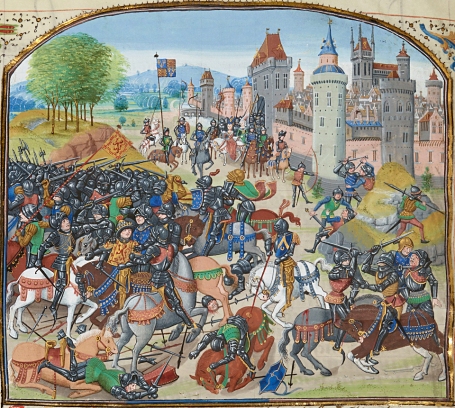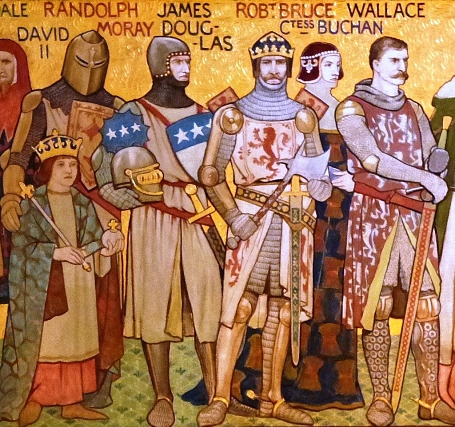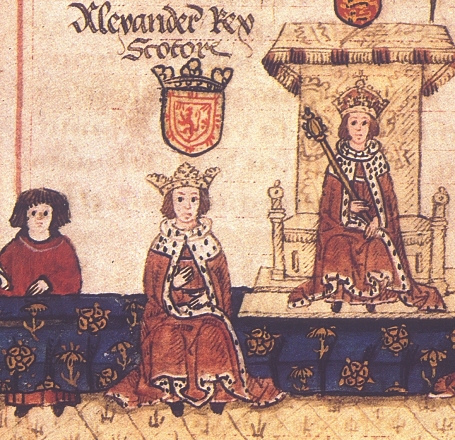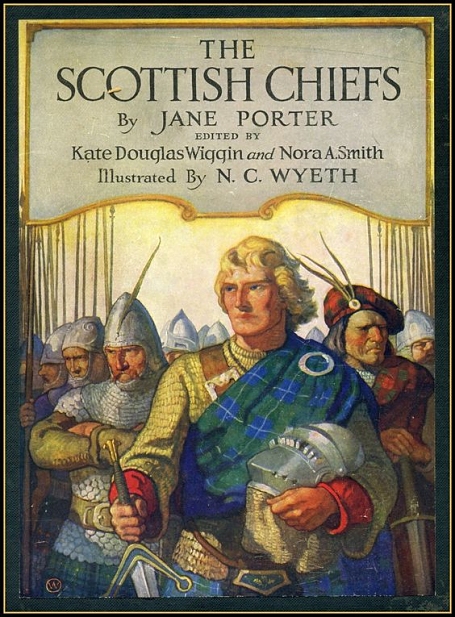The Life and Heroick Actions of the Renoun'd Sir William Wallace,
General and Governour of Scotland
by William Hamilton of Gilbertfield
Book II, Chapter IV
The Battle of LOUDON-HILL.
Now to my Purpose gladly I return,
Since I for Wallace need no longer mourn:
Who when he found himself in Case to ride,
Thought it not safe in New-Town to abide.
Then to the cruel South'rons great surprize,
Once more appears, them frights and terrifies:
His Nurse, her Daughter, Child, and Family,
He first dispatch'd away to Ellerslie.
When they were gone, no Weapon could he find
There; that could suit and please his anxious Mind.
Except a Sword, that in a Nook did stand,
O'er grown with Rust, which he took in his Hand.
He drew the Blade, and found it well could bite,
Which pleas'd his Fancy to a very Mite.
Then blythly said, "Faith thou shall go with me,
Till with a better I provided be."
To see his Uncle good Sir Rannald, then
Fain would he go, but that the English-Men;
Who cunningly for him had laid the Snare,
He fear'd, might catch him in his Journey there.
At Richartoun then longed for to be,
To get some Horse and Armour quietly,
With all Precaution Wallace ventur'd fair,
Yet met Three South'ron riding unto Ayr;
Long-Castle bold, and with him Yeo-men Two,
Wallace drew back and would not with them go.
At him they ride, and said despitefully,
"Thou Scot abide, for sure thou art a Spy:
Or else some Thief, that dares not show thy Face."
But Wallace answer'd with a modest Grace,
"Sir, I am sick, for GOD's Love let me be,
Long-Castle said, "By George that shall not be;
Thy Countenance prognostick's something Odd,
To Ayr with me thou shalt travel the Road."
Pull'd out a Sword, that was of noble Hew,
His rusty Sword, good Wallace also drew.
Then with a single, but a dreadful Blow,
He clave his Neck-Bone cliverly in Two.
The Yeo-Men then, in haste soon lighted down,
The First miss'd not a Clink out o'er his Crown,
Which to the Craig a clean Incision made;
A brave Performance by the rusty Blade.
The other fled, and durst no longer stay,
He scar'd at Blood; that was the Reason why,
But Wallace quickly brought the Culzeon back,
And there gave him the Whissle of his Plack.
Along his Ribs he gave him such a Rout,
Till all his Intralls and his Lungs hang out.
Then took their Horses, and their Armour bright,
Their noble Weapons, cliver clean and tight.
And all their Coin, syne on his Horse he cocked,
With Gold and Money jingling in each Pocket.
Then in great haste he rode to Richartoun,
A merry Meeting was at's lighting down.
Sir Richard he was there, that noble Knight,
Who mourning for him almost lost his Sight.
And his two Sons who never were so fain,
As now, to see Wallace alive again.
Sir Rannald also came to see him fast,
The Women told, by Crosby as they past,
How Wallace scap'd; Sir Rannald changed Hewes,
He wanted Faith to credit the good News.
Till he him saw, he thought the Time was long,
But when they met, who can express with Tongue,
How him he hass'd, and kiss'd so tenderly,
Till's very Soul was in an Exstasy;
The Tears of Joy which from his Eyes did flow,
E'er he could speak a long Time held him so,
But at the last, most lovingly said he,
"Welcome dear Nephew, Welcome Home to me.
Thanked be GOD that hath this Wonder wrought,
And safely out of Prison hath thee brought."
His Mother came, and Kinsfolk not a Few,
With joyful Heart, to know those Tydings true.
To Robert Boyd, that worthy was and Wight,
Wallace he was a blyth and welcome Sight.
From ev'ry different Airt they crowd and come,
To visit, and to welcome Wallace home.
Thanks be to GOD, who did to him dispense
So happy, kind, and good a Providence.
Here ends my Second Book, I say no more,
But quietly I draw a Second Score.
The ballad, The Life and Heroick Actions of the Renoun'd Sir William Wallace, General and Governour of Scotland, by William Hamilton of Gilbertfield, 1722, is in the public domain.

The Kingdom of England and the Kingdom of Scotland fought dozens of battles with each other. They fought typically over land, particularly Berwick-Upon-Tweed, and the Anglo-Scottish border frequently changed as a result. Read more at Wikipedia.

The First War of Scottish Independence was the initial chapter of engagements in a series of warring periods between English and Scottish forces lasting from the invasion by England in 1296 ... Read more at Wikipedia.

Edward I (1239-1307), also known as Edward Longshanks and the Hammer of the Scots, was King of England from 1272 to 1307. Read more at Wikipedia.

Digitized version of The Scottish Chiefs, by Jane Porter, a novelization published in 1921 by Charles Scribner's Sons, about William Wallace and the First Scottish War of Independence. Read online at archive.org.